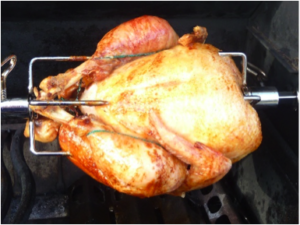Most of our pastured chickens are a little bigger than the ones mentioned in this recipe, but we think this does a nice job for a big Sunday roast dinner with the family, with some left-overs and even some soup stock.
- 2 – 5 lb chickens, whole, giblets and neck removed
- 1/4 cup olive oil
- 2 whole lemons, quartered
- 1/4 cup fresh thyme, chopped
- 1/4 cup fresh rosemary, chopped
- 1/4 cup fresh parsley, chopped
- 1 tsp crushed red pepper
- 10 cloves garlic, sliced
- 2 whole cooking onions, quartered
DIRECTIONS
- Rinse chickens with cold water; pat dry with paper towels. To prepare chickens for marinade, gently massage skin over breast and leg areas to loosen skin from the flesh. This will create a pocket between the skin and flesh.
- Combine olive oil, juice of one lemon and fresh herbs and crushed red pepper in a glass measuring cup. Gently lift skin and pour olive oil and fresh herb mixture into the pockets. Massage into breast and leg meat.
- Insert 6 sliced garlic cloves in various areas under the skin.
- Stuff remaining lemon quarters, onion and garlic cloves into the cavities of the birds. Generously sprinkle salt and pepper over outside of chickens.
- Truss the chickens tightly with cotton string. Place in resealable plastic bags and marinate in the refrigerator for at least 4 hours, or overnight.
- Rotisserie Method: Arrange your barbecue as appropriate for the size of the chickens, removing grids and warming racks if necessary, and placing a drip pan on the vapourizer. Position drip pan so that it will be centred below the chickens. Fill the drip pan to 1/2″ from the top with water, wine or fruit juice. Preheat the barbecue on MEDIUM for 10 minutes.
- To place chickens on the rotisserie, slide one of the skewer forks onto the spit, insert the spit rod into the centre of the bird, lengthwise, then dovetail the second chicken. Centre the chickens on the spit and secure them in place with the remaining fork. Tighten the forks securely. Check that they are balanced and reposition spit rod if necessary. Position the counterbalance for even rotation. To do this, lay the rod with the chickens over the kitchen sink allowing the heaviest side to turn to the bottom. With the counterbalance loosened, rotate it to the opposite side, facing up. Tighten the rod handle.
- Set the rotisserie rod in the slots of the barbecue casting. Keep an eye on the heat indicator on the lid of the barbecue and try to keep the temperature around 375°F. Check periodically to ensure that the drip pan does not run dry. Keep a pitcher of hot water handy, to refill the drip pan as it begins to evaporate.
- Cook the chickens indirectly over MEDIUM heat for approximately 1 1/2 hours, until the juices run clear, or 15–20 minutes per pound. The only way to accurately tell when the chicken is done is to use a meat thermometer. Do not allow the thermometer to touch the bone or the rotisserie spit. Chicken is done when the internal temperature of the breast meat has reached 170°F and the legs 180°F. If using a rear rotisserie burner, you may need to also set the lower burners on LOW depending on winds, external temperature etc.
- Convection Method: Refer to Rotisserie Cooking Guide for complete instructions for setting up your grill for rotisserie cooking, or for options if your grill is not equipped with a rotisserie.
- Let chickens stand for at least 10 minutes before carving.
Recipe from Gathering Around The Grill Cookbook



Recent Comments